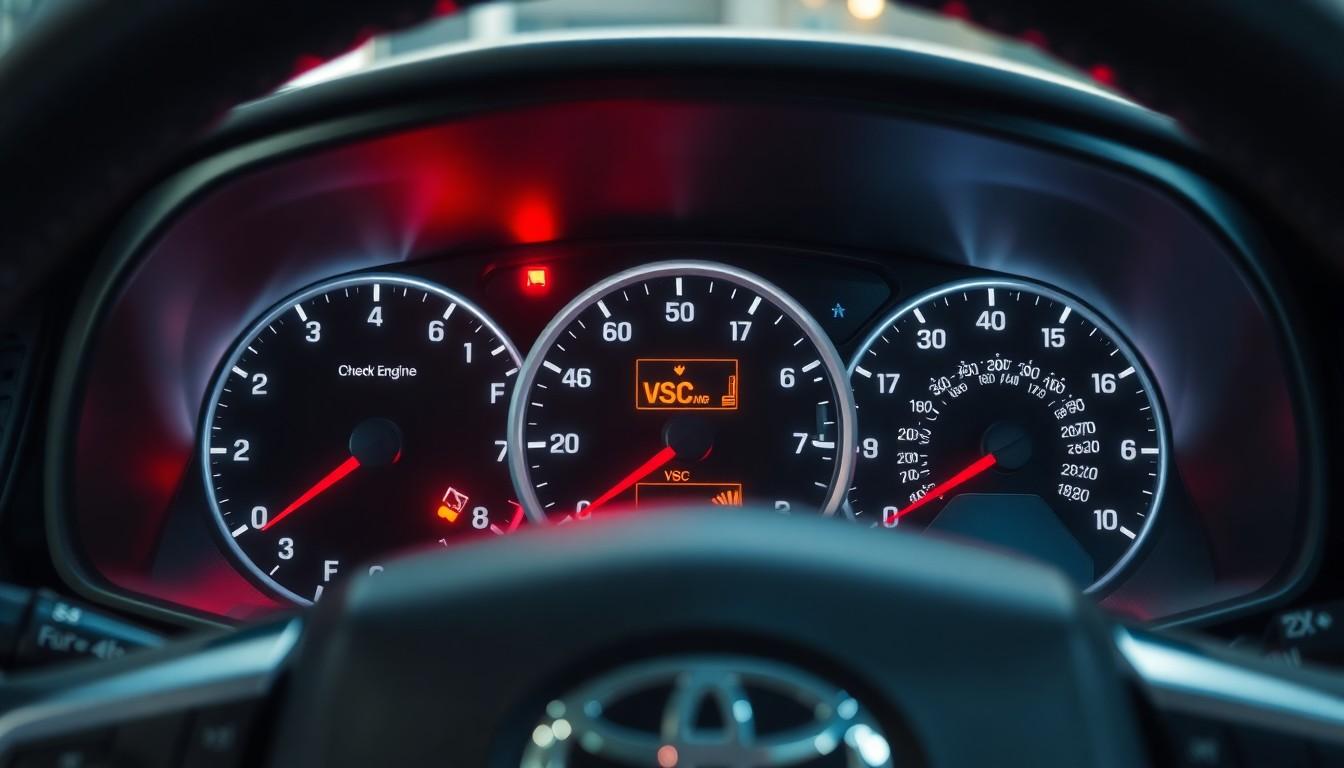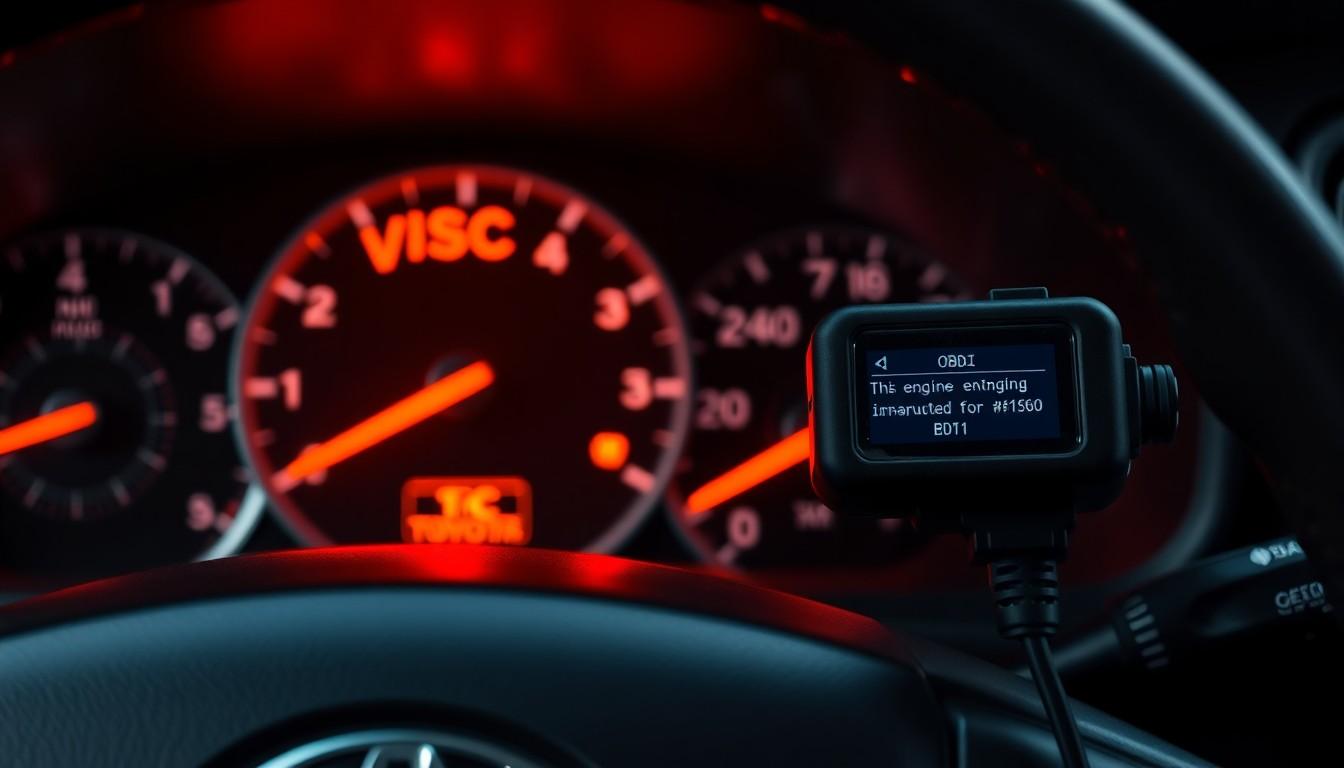That heart-sinking moment when a new dashboard light appears can leave any driver with questions. For Toyota owners, seeing the VSC OFF light alongside your check engine warning is particularly common and concerning. But what does it mean for your vehicle, and more importantly, is it safe to continue driving?
Vehicle Stability Control (VSC) is Toyota’s stability system that helps maintain traction by automatically applying brake pressure to your wheels when needed. When the VSC OFF light illuminates, it indicates the system has been disabled—either manually or due to a malfunction. This safety feature has been legally required in all U.S. vehicles since 2012, so addressing this warning promptly is essential for your safety, especially in adverse weather conditions.
Understanding Toyota VSC and Check Engine Lights
Toyota’s Vehicle Stability Control (VSC) system forms a critical part of your vehicle’s safety features. VSC helps maintain traction and control by automatically applying brake pressure to up to three wheels when needed, ensuring your vehicle stays headed in the direction your wheels are pointed. This safety feature has been mandatory in all U.S. vehicles since 2012.
What Does the VSC Light Mean?
The VSC light indicates issues with your Toyota’s electronic stability control system. When illuminated, it signals potential problems with sensors, braking systems, insufficient tire grip, or other stability control failures. Your vehicle’s stability might be compromised when this light appears, requiring immediate attention from a professional technician.
What Does VSC OFF Indicate?
VSC OFF means the stability control system has been disabled. This deactivation occurs in two ways:
- Manual deactivation through the VSC button
- Automatic deactivation by the vehicle’s onboard computer due to a system malfunction
Many Toyota models display the VSC OFF light alongside the check engine light, indicating a potential connection between these warning signals.
Relationship Between Check Engine and VSC Lights
When both the check engine and VSC lights illuminate simultaneously, they’re often related. The vehicle’s computer system typically disables the VSC system when it detects engine performance issues. This happens because:
- Engine performance directly affects the VSC system’s ability to function properly
- The onboard computer prioritizes resolving engine issues before reactivating stability control
- Related sensors and electronic components often serve both systems
TRAC OFF Light Explained
- Try pressing the traction control button to restore functionality
- Check if the check engine light is also illuminated, suggesting a deeper issue
- Remember that TRAC and VSC work together as part of your vehicle’s integrated safety system
What Does the VSC Light Mean?

The VSC (Vehicle Stability Control) light on a Toyota indicates an issue with the vehicle’s electronic body stability system. This warning light serves as an alert that your stability control system requires attention.
The Function of Vehicle Stability Control
Vehicle Stability Control works as an integral safety feature designed to maintain vehicle stability during challenging driving conditions. It helps drivers maintain control on wet, icy, or uneven roads by automatically applying brake pressure to individual wheels when needed. The system effectively limits engine power and applies strategic braking to prevent skidding or loss of control during emergency situations. VSC continuously monitors your vehicle’s direction to ensure it stays pointed where your wheels are headed, providing crucial assistance when traction becomes compromised.
Common VSC Light Patterns
The VSC light displays distinct patterns that communicate exact issues with your vehicle’s stability system. When the standard VSC light illuminates (typically yellow), it signals that the electronic body stability system has detected problems, potentially from faulty sensors, braking system issues, insufficient tire grip, or other stability control failures. The VSC Off light indicates that the system has been manually disabled, which might be intentional for exact driving conditions like handling low-grip roads. A flashing VSC Off light generally suggests either an intentional disabling or a system malfunction requiring professional diagnosis. These warning patterns shouldn’t be ignored as they directly impact your vehicle’s safety capabilities and handling performance.
Why Check Engine and VSC Lights Illuminate Together

When Toyota vehicles display both Check Engine and VSC (Vehicle Stability Control) lights simultaneously, it’s typically indicating a important issue affecting multiple systems. This dual warning is part of Toyota’s self-preservation mechanism designed to protect the engine from potential damage when malfunctions are detected.
Shared Electronic Systems
Toyota’s engine management and stability control systems rely on an interconnected network of electronic components and sensors. These shared systems create a situation where a problem in one area can trigger warnings across multiple vehicle functions. The VSC system automatically disables when the engine control module detects certain issues, causing both warning lights to illuminate at once. This integrated approach to vehicle electronics means that diagnosing the root cause often requires examining how these systems interact rather than treating them as separate entities.
Common Causes for Dual Warning Lights
Several exact issues commonly trigger both the Check Engine and VSC lights in Toyota vehicles:
- Faulty Sensors: Malfunctioning mass airflow sensors, intake air temperature sensors, and oxygen sensors frequently cause both lights to activate
- Gas Cap Issues: A loose, damaged, or missing gas cap disrupts the evaporative emission system, triggering multiple warning lights
- Vacuum Leaks: Cracks or disconnections in the engine’s vacuum system affect both engine performance and stability control functions
- Electrical Problems: Wiring failures, corroded connections, or module malfunctions in the electrical system prompt both warning indicators
- Brake Fluid Levels: Low brake fluid can activate the VSC light while accompanying engine issues trigger the Check Engine light
- Emission System Problems: Damaged evaporative emission components such as canisters and hoses often result in dual warning lights
- Engine Misfires: Combustion irregularities affect both engine performance and the stability control system’s operation
These dual illuminated lights shouldn’t be ignored, as they indicate the VSC and TRAC (Traction Control) systems have been automatically disabled to prevent further strain on the engine. Prompt diagnosis with a code reader helps identify the exact malfunction and restore these crucial safety systems.
Diagnosing VSC and Check Engine Light Issues

When both the VSC and Check Engine lights illuminate on your Toyota’s dashboard, it’s critical to determine the root cause. These warning lights often indicate interconnected issues that affect multiple vehicle systems and require proper diagnostic techniques to resolve.
Using OBD-II Scanners
OBD-II scanners serve as essential diagnostic tools for identifying the exact issues triggering your Toyota’s warning lights. These devices connect to your vehicle’s onboard computer system and retrieve stored error codes that point to the exact problem. Basic scanners may only read general engine codes, while advanced diagnostic tools can access detailed information about both Check Engine and VSC light issues. Professional-grade scanners provide comprehensive data about system malfunctions, sensor readings, and performance metrics that help technicians pinpoint the exact cause of the problem. After repairs are completed, technicians use these same scanners to clear the error codes from your vehicle’s computer, effectively resetting the warning lights.
Common Error Codes
Error codes from your Toyota’s computer system offer exact insights into what’s causing your VSC and Check Engine lights to activate. Several common codes relate to the evaporative emission system, including P0446 (evaporative emission control system vent control circuit malfunction), P0455 (evaporative emission control system leak detected – large leak), and P0441 (evaporative emission control system incorrect purge flow). These codes often point to issues like a loose gas cap, disconnected evap canister or hose, vacuum leaks at the engine, or a faulty purge solenoid. The ABS system, which works along with VSC, might trigger codes related to wheel speed sensors or control module malfunctions. Engine-related problems such as faulty throttle position sensors, air quality monitoring sensors, or fuel system issues can also generate exact error codes. Technicians use these codes as starting points for further testing and diagnosis, narrowing down potential causes before performing targeted repairs.
Troubleshooting Steps for VSC and Check Engine Lights

When both the VSC (Vehicle Stability Control) and check engine lights illuminate on your Toyota’s dashboard, they’re indicating issues that require attention. These warning lights often appear together because Toyota’s stability control systems are interconnected with engine management functions.
Quick Fixes You Can Try at Home
Gas cap issues frequently trigger these warning lights. Inspect your gas cap for damage and ensure it’s tightly secured with a proper click. A loose or damaged cap can activate both lights due to pressure changes in the fuel system.
Battery resets sometimes resolve temporary glitches. Disconnect the negative battery cable, wait 30 seconds, then reconnect it to reset the vehicle’s computer system. This method doesn’t fix underlying issues but may clear temporary electronic errors.
Checking your oil level and condition is essential as low or dirty oil can trigger warning lights. Engines with low oil levels may develop performance issues that affect multiple vehicle systems simultaneously.
Vacuum leaks around the engine create air-fuel mixture problems that trigger warning lights. Inspect all visible hoses and connections for cracks, loose fittings, or disconnected parts in the evaporative emission system.
When to Seek Professional Help
Diagnostic scanning becomes necessary when home remedies don’t resolve the issue. Professional mechanics use OBDII scanners to read exact error codes from your vehicle’s computer, pinpointing exact problems causing the light activation.
Spark plug and ignition coil problems, particularly common in Toyota’s 3.5 V6 2GR-FE engines, require professional attention. These issues cause misfires and shuddering that trigger both warning lights while decreasing fuel efficiency.
ABS system malfunctions often trigger VSC lights as these systems work together. Only trained technicians can safely diagnose and repair complex brake system electronics that affect vehicle stability.
Emission system troubles beyond a simple gas cap issue need professional diagnosis. Components like evaporative canisters and related valves require specialized tools and expertise to properly test and repair.
System-exact issues related to the VSC hardware itself need professional intervention. When the VSC system has been disabled by the onboard computer due to a detected malfunction, professional diagnostics prevent further damage to your engine and related systems.
Driving Safety Considerations

Driving with VSC and check engine lights illuminated presents serious safety concerns that require immediate attention. Toyota’s stability control system plays a vital role in maintaining vehicle control during hazardous conditions, and when compromised, driving safety is significantly affected.
Is It Safe to Drive With VSC Light On?
Driving with only the VSC light on involves moderate risk that depends on current road conditions. Your vehicle’s stability control system remains compromised when this light appears, reducing its ability to correct skids or maintain traction during emergency maneuvers. Drivers face increased danger particularly on wet, icy, or uneven road surfaces where stability control provides critical assistance. The VSC system automatically applies brake pressure to individual wheels to keep your vehicle pointed in the intended direction – a function you’ll lack when this warning light remains illuminated.
When both the VSC and check engine lights appear simultaneously, safety concerns become much more serious. This combination often indicates interconnected problems affecting multiple vehicle systems, potentially placing the vehicle in “limp mode” to prevent additional damage. Continuing to drive in this state could lead to unexpected performance issues, complete system failures, or accidents due to compromised vehicle stability and handling.
The most severe situation occurs when these warning lights appear alongside physical symptoms like engine shaking, power loss, or strange noises. These manifestations signal critical malfunctions that demand immediate action – pull over when safe and arrange for professional assistance rather than continuing your journey. Many Toyota owners report that driving with both lights on has resulted in sudden loss of power or control during critical driving moments.
We recommend treating the dual illumination of VSC and check engine lights as an urgent safety matter requiring prompt professional diagnosis and repair. Your vehicle’s stability control serves as an essential safety system, and compromising its functionality puts you and your passengers at unnecessary risk.
Preventing Future VSC and Check Engine Light Issues

Regular Maintenance
Regular maintenance serves as the cornerstone of preventing VSC and Check Engine light issues in Toyota vehicles. Scheduling consistent oil changes and tire rotations keeps your vehicle in optimal condition and helps avoid system malfunctions. Checking your gas cap for damage or looseness is particularly important, as a faulty gas cap commonly triggers both the Check Engine and VSC lights due to problems with the evaporative emission system. The evap system requires regular inspection to ensure hoses, canisters, and related components remain in good working order.
System Component Care
Toyota’s VSC system relies on multiple components working together flawlessly. Vacuum leaks frequently cause both Check Engine and VSC light activations, so inspecting the engine’s vacuum system routinely can prevent unexpected warnings. The ABS system directly connects to VSC functionality, making brake system maintenance critical for preventing stability control warnings. Checking brake fluid levels regularly ensures they don’t fall below the recommended level, which can trigger system warnings. Traction control issues, including malfunctioning wheel speed sensors, often lead to VSC light illumination.
Sensor Maintenance
Sensors play a crucial role in your Toyota’s VSC system performance. Regular cleaning and inspection of oxygen sensors, wheel speed sensors, and throttle position sensors prevent malfunctions that trigger warning lights. Dirty or failing sensors send incorrect data to your vehicle’s computer system, resulting in false positive warnings or actual system shutdowns. Air filter maintenance, including replacing both cabin and engine air filters as recommended, prevents dirty air from affecting engine performance and related stability systems.
Fuel System Care
Fuel system issues frequently trigger multiple warning lights in Toyota vehicles. Using fuel injector cleaners periodically keeps the fuel injectors functioning properly and prevents related system errors. Clean fuel injectors ensure proper combustion, which helps maintain the precise engine performance needed for VSC system operation. Mechanical issues with fuel delivery components can affect both engine performance and stability control systems, highlighting the interconnected nature of these systems.
Professional Diagnostics
Professional diagnostics serve as an essential preventive measure for Toyota VSC and Check Engine light issues. Using a sophisticated scanner during regular maintenance checks helps identify potential problems before they trigger warning lights. These advanced scanners retrieve error codes that pinpoint exact issues within the vehicle’s complex systems. Regular professional inspections by qualified mechanics catch developing problems before they escalate into system failures that disable critical safety features like VSC.
Conclusion
Taking immediate action when your Toyota’s VSC and check engine lights illuminate is crucial for your safety. These warnings signal potentially serious issues that affect multiple systems in your vehicle.
While some simple fixes like checking the gas cap or resetting the battery might resolve minor problems we strongly recommend professional diagnostics for persistent warnings. The interconnected nature of Toyota’s stability control and engine management systems means that ignoring these lights puts you at risk.
Remember that regular maintenance is your best defense against these issues. By addressing warning lights promptly you’ll not only keep your vehicle’s critical safety systems functioning properly but also prevent more expensive repairs down the road.
Your Toyota’s warning systems exist for your protection—trust what they’re telling you and respond accordingly.
Frequently Asked Questions
What does the VSC OFF light mean on my Toyota?
The VSC OFF light indicates your Vehicle Stability Control system has been disabled. This could happen either because you manually turned it off using the VSC button, or because the system detected a malfunction and automatically disabled itself. Since VSC helps maintain traction in challenging driving conditions, having it disabled reduces your vehicle’s safety capabilities, especially on slippery roads.
Why are my VSC and Check Engine lights on simultaneously?
When both VSC and Check Engine lights illuminate together, it typically indicates that an engine performance issue is affecting your stability control system. Toyota designs these systems to be interconnected—when the engine management system detects a problem, it often disables the VSC system as a protective measure. This dual warning should never be ignored as it affects critical safety features.
Can I drive my Toyota when both VSC and Check Engine lights are on?
Driving with both lights illuminated poses significant safety risks. While short, careful trips to a repair facility are possible, extended driving is not recommended. Your vehicle’s stability control is disabled, reducing handling capabilities, especially in adverse conditions. If you experience additional symptoms like engine shaking or power loss, stop driving immediately and call for professional assistance.
What are common causes for VSC and Check Engine lights activating together?
Common causes include: loose or damaged gas cap, faulty oxygen or mass airflow sensors, vacuum leaks in the engine, low brake fluid, emission system problems, engine misfires, or electrical issues. The interconnected nature of Toyota’s systems means that even seemingly minor issues can trigger multiple warning lights as the vehicle’s computer attempts to protect critical components.
How can I diagnose VSC and Check Engine light issues?
Start with an OBD-II scanner to retrieve error codes from your vehicle’s computer system. These codes will point to specific problems triggering the warnings. Common codes relate to the evaporative emission system, ABS system, or engine performance issues. While some basic diagnosis can be done at home, professional technicians have specialized equipment to accurately identify and fix the underlying issues.
Are there any quick fixes I can try at home?
Some simple troubleshooting steps include: checking and tightening your gas cap, inspecting oil levels, looking for obvious vacuum leaks, and performing a battery reset (disconnecting the battery for 10-15 minutes). While these may temporarily resolve minor issues, persistent warning lights require professional diagnosis to address the root cause and prevent potential damage to your vehicle.
How important is regular maintenance in preventing these warning lights?
Regular maintenance is crucial for preventing VSC and Check Engine light issues. Consistent oil changes, tire rotations, and inspection of critical components like the gas cap, vacuum system, and sensors can prevent many problems that trigger these warnings. Professional diagnostic checks during routine maintenance can identify potential issues before they escalate to system failures.
What happens if I ignore these warning lights?
Ignoring both VSC and Check Engine lights can lead to serious consequences. Without the stability control system, your vehicle has reduced handling capabilities in emergency situations. The underlying engine issue causing the warnings may worsen, potentially leading to expensive repairs or complete system failures. Additionally, continuing to drive may put you and others at increased safety risk, particularly in adverse weather conditions.

